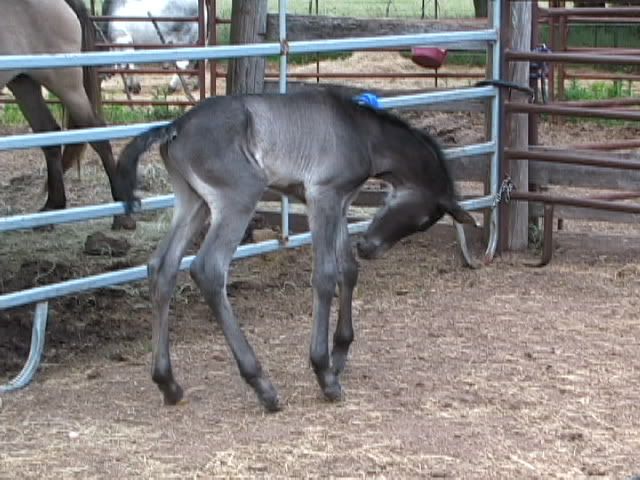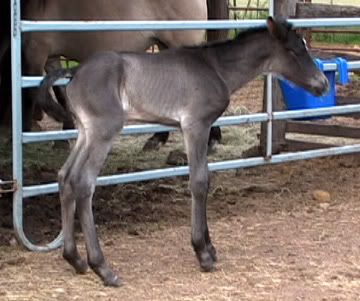|
|
ChaCha!
Nov 21, 2011 7:43:59 GMT -5
Post by Michelle Clarke on Nov 21, 2011 7:43:59 GMT -5
|
|
grullagirl
Weanling
  Have you hugged your horse today?
Have you hugged your horse today?
Posts: 238
|
ChaCha!
Nov 21, 2011 9:11:38 GMT -5
Post by grullagirl on Nov 21, 2011 9:11:38 GMT -5
I just love ChaCha's look. She resembles Hipo to a T. Gringo and and Chacha would be a very interesting cross for sure!
|
|
|
|
ChaCha!
Nov 25, 2011 3:20:49 GMT -5
Post by sbutter on Nov 25, 2011 3:20:49 GMT -5
Boy is she black! At first glance it looked like someone cut out an outline of the horse in the pictures lol. She looks like a fun mare to train  I love the feisty ones. |
|
|
|
ChaCha!
Nov 25, 2011 15:36:17 GMT -5
Post by barbhorses on Nov 25, 2011 15:36:17 GMT -5
She sure is a lovely black mare! I agree on the Lusitano part, though you can see Kiger in her as well. It sounds like she got a more Lusitano temperament too! I remember seeing a picture of her where her legs looked like they had black stockings as her coat appeared faded. I sent Dr. Sponenberg a link to her and wondered if that was normal and he said yes. He said that sometimes black horses will fade differently from year to year (I find that interesting! I didn't know that). This of course is assuming that it isn't a rare black that doesn't fade.
|
|
|
|
ChaCha!
Nov 25, 2011 18:46:08 GMT -5
Post by DianneC on Nov 25, 2011 18:46:08 GMT -5
What is the difference in his opinion in the genes that make a non-fading black?
|
|
|
|
ChaCha!
Nov 25, 2011 20:27:43 GMT -5
Post by barbhorses on Nov 25, 2011 20:27:43 GMT -5
I didn't ask him. My conversation with him stemmed from a heated conversation on this board regarding dun horses that appear black or bay. I didn't post his responses (though he gave permission to share his opinions) as I didn't want to stir the pot. Here is his email so that you may ask him directly.  dpsponen@vt.edu |
|
grullagirl
Weanling
  Have you hugged your horse today?
Have you hugged your horse today?
Posts: 238
|
ChaCha!
Nov 25, 2011 21:49:12 GMT -5
Post by grullagirl on Nov 25, 2011 21:49:12 GMT -5
Chacha is actually a dark grulla and not a true black horse. Generally her ears have lighter coloring inside which gives away the dun gene. I've also seen her stripes although they get harder to see when she darkens up. She is definately one of my favorite horses out their. You just gotta love the bullfighting lines!  |
|
|
|
ChaCha!
Nov 25, 2011 22:44:15 GMT -5
Post by barbhorses on Nov 25, 2011 22:44:15 GMT -5
I asked Dr. Sponenberg about the buff colored ears indicating a grulla pattern and that wasn't something that he believed indicated dun factor. He felt that if the horses were genetically tested that they would turn out as a regular black. Actually, the Ravenseyrie Sorraia Mustang gal had her two "dark grullas" tested and they didn't come up with a dun gene. I believe that it was inconclusive (that is what she said, she didn't post the actual results). Her other regular colored dun horses came up either D/N or D/D.
|
|
|
|
ChaCha!
Nov 26, 2011 1:58:11 GMT -5
Post by DianneC on Nov 26, 2011 1:58:11 GMT -5
She sure has a beautiful trot!
|
|
|
|
ChaCha!
Nov 26, 2011 7:03:52 GMT -5
Post by Michelle Clarke on Nov 26, 2011 7:03:52 GMT -5
Honestly, I don't think enough is known about a lot of colors, mainly dun and sooty; and how they act or react with other colors. Just as you have to have two pearl genes or one pearl and one cream to come up with a dilute look. Another example is how the cream gene can mask the dun factor by being too light, I know the sooty surely can act too dark and cover dun up. Including ChaCha, there are a few horses I have that I will be breeding to non-dun Lusitanos in the future in order to test some theories. I look forward to the results.
IME, over the years, I have found that buff colored ears are indicative of some dilution. Whether it be dun or smokey black. Since we have an opportunity here having so many horses come and go, I've paid a lot of attention to this.
|
|
|
|
ChaCha!
Nov 26, 2011 7:04:43 GMT -5
Post by Michelle Clarke on Nov 26, 2011 7:04:43 GMT -5
Thanks Dianne...she will really be something when she gets that neck out of her shoulder and learns to use herself better!
|
|
|
|
ChaCha!
Nov 26, 2011 11:46:42 GMT -5
Post by DianneC on Nov 26, 2011 11:46:42 GMT -5
I've puzzled over that as well. I agree with the light ears, either dun or creme is there. Chinook threw either really light or really dark grullas. Any mid level color came from the dam. Tia, Chinook's dam was zebra dun but was darker in her face. Since she definitely had one bay gene, one black gene and one sooty gene that she passed to Chinook, and a potent one at that, why wasn't she copper dun? I think because she was homozygous for dun. Same with Lark, zebra dun, but she has Cowboy's mild sooty gene - you can see it in her mask but she looks dun, not copper dun. In looking at Blue I see mild sooty on grulla. Since Chinook only threw light or dark, he must have given Blue a light gene and the mild sooty came from Lark.
So my theory is that copper duns have one dun gene. These zebra duns with darkness in their mask have been a puzzle to me. They throw sooty but their coats aren't dark. Why not? It would seem to me that the bay gene which lightens the coat, plus two dun genes which lighten the coat can compensate for a sooty gene, which adds black back to the coat.
|
|
|
|
ChaCha!
Nov 26, 2011 12:28:55 GMT -5
Post by Michelle Clarke on Nov 26, 2011 12:28:55 GMT -5
The only black looking foals Charro has had has been from Chilli, who obviously has the sooty gene. They also had one darker colored grullo, Chach, who is close to Charro in color. Then they had three red duns, none of which even had dark manes/tails. Chilli also had a filly by Desi (red dun Charro son w/sooty) who actually has almost a flaxen mane (Nali). Desi had one filly the same color as him, with a very dark mane/tail (Cora). So why hasn't Chilli had any chestnut colored foals, especially with Charro? It would have made sense to me after having two non-dun black looking foals that at some point, she would have had a red based one. Odds sure seemed in that favor. Chilli, has had three cream foals, one dark dark golden palomino, a buttermilk buckskin and now Max, who is a deep body color with dark very visible stripes on his legs and dorsal. The two black looking foals were both born grullo. I'll have to scan some picts of Loba but she was the same color as Pache; shown here at a few hours old.   |
|
|
|
ChaCha!
Nov 26, 2011 12:51:18 GMT -5
Post by Michelle Clarke on Nov 26, 2011 12:51:18 GMT -5
Here is a page with all Chillis' foals on it. This is the updated Rancho Bayo site I've been working on, so it is not finished and all the links, etc. are not up yet... m.clarketx.tripod.com/rb2011/chilli.html |
|
|
|
ChaCha!
Nov 26, 2011 13:17:08 GMT -5
Post by barbhorses on Nov 26, 2011 13:17:08 GMT -5
"From: "Sponenberg, D. Phillip" <dpsponen@vt.edu>
To: Kimberlee Jones <espanaantigua@yahoo.com>
Sent: Thursday, October 27, 2011 6:02 AM
Subject: Re: Color
"sooty" may not all be one gene. Also, it is pretty rare to come across a coyote dun, while "brown" horses are common. So, it seems that it is not expressed too well in most duns. On foals it's also best to see what happens as they mature – betting on foal colors is a good way to lose money!
--
D. Phillip Sponenberg, DVM, PhD
Professor, Pathology and Genetics
225 Duck Pond Drive
Virginia-Maryland Regional College of Veterinary Medicine
Virginia Tech
Blacksburg, VA 24061
USA"
|
|